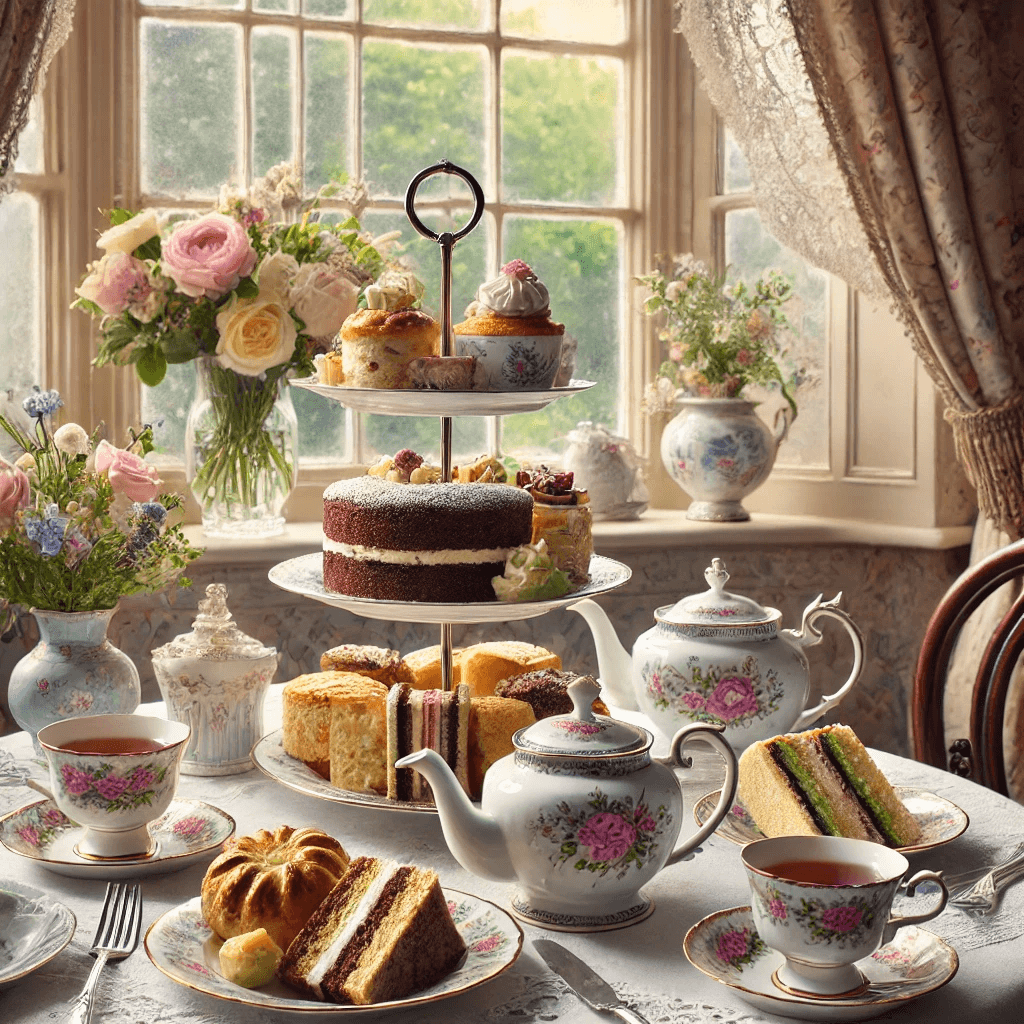The Origins of Afternoon Tea

The Origins of Afternoon Tea
Afternoon tea is one of Britain’s most beloved traditions, conjuring images of elegant china, delicate pastries, and leisurely social gatherings. While today it is often associated with indulgence and refinement, afternoon tea originally arose as a practical solution to a common problem—how to stave off hunger in the long hours between lunch and a late evening dinner. Over time, it became a symbol of sophistication, evolving into an elaborate ritual accompanied by a selection of iconic baked goods.

The Birth of Afternoon Tea
Tea drinking was introduced to England in the 17th century by King Charles II and his Portuguese wife, Catherine of Braganza, but it wasn’t until the 1840s that the concept of afternoon tea was introduced. The credit for this refined tradition goes to Anna Russell, Duchess of Bedford, who found herself feeling peckish in the late afternoon due to the long wait for dinner, which was often served as late as 9 p.m. She began requesting tea, bread and butter, and small cakes to be served in her private quarters.
What started as a private refreshment quickly turned into a fashionable social gathering. The Duchess began inviting friends to join her, and soon, afternoon tea became an aristocratic trend, particularly among Edwardian high society. It also provided an opportunity for hosts to showcase their finest china, table linens, and silverware, elevating the event to a display of wealth and refinement.
Interestingly, the well-known practice of raising a pinkie finger while drinking tea is believed to have originated with a noblewoman. As admiration for the Royal Family was widespread, people began imitating the gesture, assuming it to be a mark of sophistication.
Though its popularity waned after World War II, afternoon tea has experienced a revival in modern times, particularly in luxury hotels and tearooms, where it remains a cherished tradition.
The Difference Between Low Tea and High Tea
The terms “high tea” and “low tea” are often confused. In Victorian Britain, there were actually two types of tea traditions:
Low Tea: Enjoyed by the upper classes, this was served on low tables in drawing rooms with comfortable chairs. It was a refined social occasion, featuring delicate finger sandwiches, cakes, and pastries.
High Tea: Contrary to popular belief, this was not an aristocratic event but rather an evening meal for the working class. It was served at a high dining table and typically consisted of hearty dishes like meats, bread, and robust tea—more of a dinner than a light snack.
The Classic Bakes of Afternoon Tea
No afternoon tea is complete without an array of delicious baked goods. While many treats have graced the tea table over the years, some have become true staples of this refined tradition.
1. Scones with Clotted Cream and Jam
Surprisingly, scones were not originally part of afternoon tea; they only became a staple in the early 1900s. Traditionally served warm, scones are best enjoyed split in half, with clotted cream and strawberry jam. The Devon vs. Cornwall debate—whether to spread the cream or jam first—remains a subject of friendly rivalry to this day.
2. Victoria Sponge Cake
This light, airy sponge cake filled with jam and cream is named after Queen Victoria, who was known to enjoy a slice with her afternoon tea. However, the recipe itself originated in Spain, dating back to the Renaissance era. It wasn’t until it became one of the Queen’s favorites that it was renamed in her honor.
To be considered a true Victoria sponge, the cake must contain both jam and cream—otherwise, it’s simply a jam sponge!
3. Battenberg Cake
Recognizable by its iconic checkerboard pattern, Battenberg cake is wrapped in marzipan and features alternating pink and yellow sponge squares. It is believed to have been created in 1884 to commemorate the marriage of Princess Victoria (Queen Victoria’s granddaughter) to Prince Louis of Battenberg.
4. Madeleines
Though these shell-shaped sponge cakes are of French origin, their delicate texture and buttery flavor make them a perfect accompaniment to English afternoon tea.
5. Shortbread
A Scottish classic, shortbread is a rich, crumbly biscuit made with only butter, sugar, and flour. It pairs beautifully with tea and has been enjoyed in Britain for centuries.
6. Lemon Drizzle Cake
A delightful balance of sweet and tangy, lemon drizzle cake features a moist sponge infused with fresh lemon juice and topped with a sugary glaze. This zesty treat provides a refreshing contrast to the richer items on a traditional tea table.
7. Eccles Cakes
Named after the town of Eccles in Lancashire, these small, round pastries are filled with spiced currants and wrapped in flaky pastry. Though they predate the invention of afternoon tea, they became a favorite addition due to their sweet and buttery flavor
The Modern-Day Tradition
Though afternoon tea is no longer a daily occurrence, it remains a special indulgence. While the classic elements of afternoon tea persist, many modern variations have emerged, including themed tea menus and luxury afternoon tea experiences. Upscale hotels and tea rooms continue to offer elegant afternoon teas, often featuring seasonal or international flavors, catering to both tradition and innovation.
Whether enjoyed in a grand hotel, a cozy tearoom, or at home with homemade bakes, afternoon tea continues to celebrate elegance, indulgence, and social charm. So next time you sit down for tea, why not raise a pinkie, enjoy a scone, and embrace the timeless charm of this beloved British tradition?
Share your thoughts
Did you find this history article interesting? Rate it below and let others know!